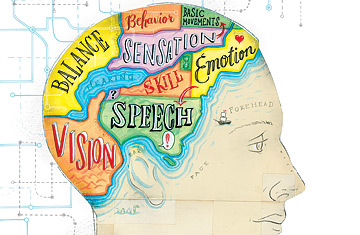 Trying to map the brain has always been cartography for fools. Most of the other parts of the body reveal their workings with little more than a glance. The heart is self-evidently a pump; the lungs are clearly bellows. But the brain, which does more than any organ, reveals least of all. The 3-lb. lump of wrinkled tissue--with no moving parts, no joints or valves--not only serves as the motherboard for all the body's other systems but also is the seat of your mind, your thoughts, your sense that you exist at all. You have a liver; you have your limbs. You are your brain.
Trying to map the brain has always been cartography for fools. Most of the other parts of the body reveal their workings with little more than a glance. The heart is self-evidently a pump; the lungs are clearly bellows. But the brain, which does more than any organ, reveals least of all. The 3-lb. lump of wrinkled tissue--with no moving parts, no joints or valves--not only serves as the motherboard for all the body's other systems but also is the seat of your mind, your thoughts, your sense that you exist at all. You have a liver; you have your limbs. You are your brain.
The struggle of the mind to fathom the brain it inhabits is the most circular kind of search--the cognitive equivalent of M.C. Escher's lithograph of two hands drawing one another. But that has not stopped us from trying. In the 19th century, German physician Franz Joseph Gall claimed to have licked the problem with his system of phrenology, which divided the brain into dozens of personality organs to which the skull was said to conform. Learn to read those bony bumps, and you could know the mind within. The artificial--and, ultimately, racist--field of craniometry made similar claims, relying on the overall size and shape of the skull to try to determine intelligence and moral capacity.
Modern scientists have done a far better job of things, dividing the brain into multiple, discrete regions with satisfyingly technical names--hypothalamus, caudate nucleus, neocortex--and mapping particular functions to particular sites. Here lives abstract thought; here lives creativity; here is emotion; here is speech. But what about here and here and here and here--all the countless places and ways the brain continues to baffle us? Here still be dragons.
Slowly, that is changing. As 21st century science and technology open the brain to us as never before, accepted truths are becoming less true. The brain, we're finding, is indeed a bordered organ, subdivided into zones and functions. But the lines are blurrier than we ever imagined. Lose your vision, and the lobe that processed light may repurpose itself for other senses. Suffer a stroke in the area that controls your right arm, and another area may take over at least some of the job.
Specialized neurons are being found that allow us to mirror the behavior of people around us, helping us learn such primal skills as walking and eating as well as how to become social, ethical beings. The mystery of memory is being teased apart, exposing the way we store facts and experiences in addition to the emotional flavors associated with them. Magnetic resonance imaging is probing the brain as it operates, essentially--if crudely--reading our minds, and raising all the attendant ethical questions.
Finally and most elusively, we are learning something about consciousness itself--the ghost in the neural machine that gives you the sense of being in the moment, peering out at the world from the control room behind your eyes. If we can identify that cognitive kernel, can we one day endow a machine with it? But by isolating such a thing, do we in some way annihilate it too?
Human beings have always been brash enough to ask such questions but lacked the necessary gifts to answer them. At last, we are acquiring that ability. What we can't yet know is whether we will wisely use the remarkable things we're slowly learning.